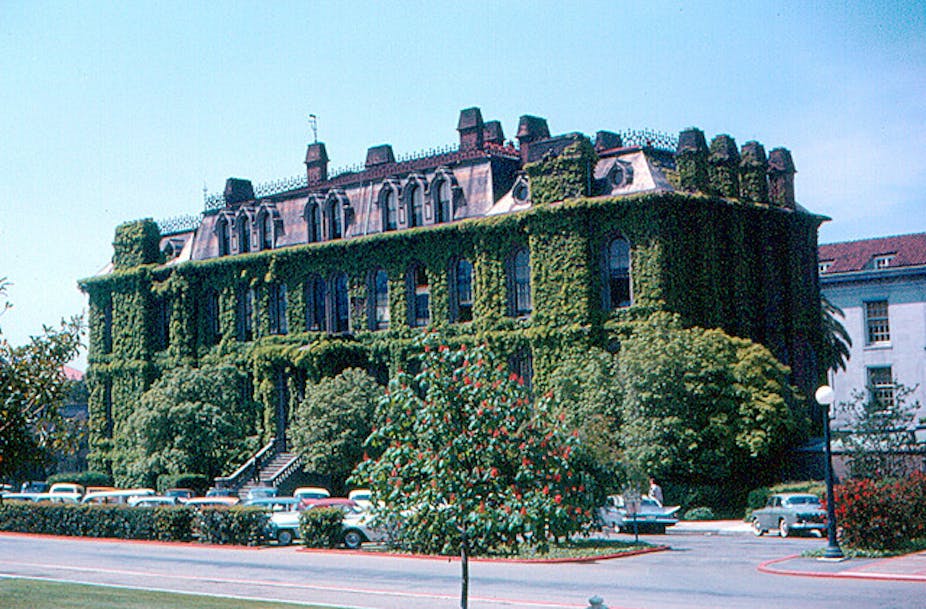California has been the crest of modernity since the end of the second world war. The tendencies and tensions of the times show there first. In only 14 years, California invented student power (Berkeley 1964), hippies and the counter-culture (San Francisco 1967), and the tax revolt (Proposition 13 1978). All went on to sweep the world. Then there’s Silicon Valley and Steve Jobs, not to mention film and TV. We all live in California, some of the time.
In the past fifty years California has also led the world in higher education and university-based science. California is unmatched in its concentration of private campuses (Stanford, Caltech, the University of Southern California), and public campuses (Berkeley, UCLA, UC San Diego). Only the Boston corridor is in the same league, and it lags well behind.
Perhaps more surprisingly - given the high capitalist ideology in California today - the state also long led the world in public planning and social access to higher education.
The Master Plan
The shining moment was the 1960 Master Plan, led by Clark Kerr, then president of the public system of nine (now ten) research university campuses known as the University of California (UC).
The Master Plan was agreed on by the State Governor and legislature at a time, long since gone, when California led the United States in its rate of participation in higher education. The plan enshrined a high access model based on equality of opportunity, funded by the state, with low tuition charges.
The cost of student participation was limited by channelling most of the growth into two-year community colleges, and confining the research-intensive campuses of the University of California to the top 12.5% of school leavers. In between lay the four-year California State University sector.
The barriers generated by this highly stratified system of participation (in many countries half or more students enter research universities) were meant to be offset by upward transfer of a good proportion of students from the community colleges to the California State Universities or the University of California campuses.
The distinctive feature of the Master Plan was the three sectors of higher education with carefully segmented missions. The Plan was hailed nationally and internationally as a mechanism that combined excellence in the top tier universities with universal access. The extraordinary transformation of higher education in China since the late 1990s has been partly patterned on California.
Seven of the University of California campuses are positioned in the world’s top 50 research universities, and nine are in the top 150. They are not as strong as they were in competition with Stanford and Harvard for top researchers, but on the whole the excellence part has worked. The access part has proven more difficult.

Access for all?
The elite UC campuses are relatively equitable. Students from poor families, and first generation higher education students, are much better represented in UC than in private universities like Stanford. Both Berkeley and UCLA each have more low-income students than the whole Ivy League; 40% of Berkeley undergraduates pay no tuition; 65% receive financial aid; and half graduate with no debt.
But this is a drop in the ocean of a highly unequal education system. In the United States in 2011, of people in the top income quartile, 71% completed college by early adulthood, up from 40% in 1970. In the bottom quartile the completion rate had also increased — but only from 6% to 10%. In the second bottom quartile it rose from 11 to 15%. The bottom half of the population is largely shut out.
School retention in California was just 78.5% in 2012, with stark inequalities between rich and poor districts: 73.2% of Latinos and 65.7% of Afro-Americans completed school in 2012. The quality of community colleges and California State Universities is uneven by locality, and upward transfer rates are very patchy.
Proposition 13 is to blame
The culprit is Proposition 13, which enshrined the doctrine that government tax/spend is a violation of individual liberty. The proposition made it very difficult to increase taxes, and triggered recurring budget crises. Since the prolonged recession that began in 2008, California has chopped off one third of state funding for higher education. All levels of institution are turning away qualified applicants for the first time since 1960. Community colleges no longer provide opportunity for all.
Institutions face an impossible choice between steeply hiking tuition (blocking access) or allowing material conditions to further deteriorate and educational inequalities to widen.
Alternatively, Californians will find ways to regenerate public support for common provision and equality of opportunity.
Simon Marginson gave a series of Clark Kerr Lectures on Higher Education on the past, present and future of public higher education in California.

